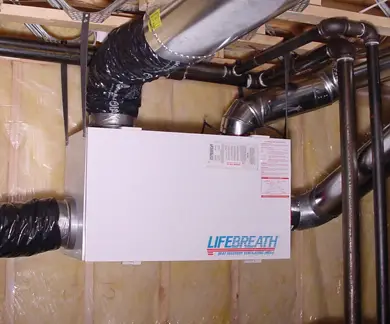When it comes to indoor air quality, I’ve got some good news and some bad news.
The bad news is that the air in your home probably isn’t as good as it should be. In fact, the air in some homes wouldn’t even pass labor inspections if it existed in an industrial situation. Ever since home building strategies evolved to produce tighter structures, beginning in the early 1970s, the recognition of indoor air quality as a legitimate issue has lagged behind the technical know-how needed to improve it.
The good news is that there are effective ways to make the situation better.
It’s no surprise that low indoor air quality is most likely to occur in the winter, when windows and doors are closed tightly against the weather, and fireplaces, heaters and furnaces are running full blast.
Identifying Bad Indoor Air
Luckily, winter is also the best time to identify bad indoor air. If your windows sport at least two panes of glass, yet still develop enough condensation to form running droplets, then you’ve got an indoor air quality problem that goes beyond just moldy window sills. As troublesome as it is, window condensation is an excellent air quality yardstick.
Home Pollutants
Canadians spend over 90% of their time indoors, and this means we’re exposed to pollutants that come from our homes. The most common include:
- Formaldehyde gas from building products
- Volatile organic compounds (VOCs) from paint
- Floor coverings
- Cleaning products
- In some regions, naturally occurring soil-borne radon gas makes its way into basements, boosting cancer rates.
Now, before you sell your house and move into a tent, listen to some good news. It’s all about a three-phase ventilation strategy that improves indoor air quality while demanding the least amount of money to get the job done.
1) Make a Start
- In its simplest form, getting fresh air into your home isn’t complex.
- Simply open a window or two during winter and operate existing exhaust fans diligently.
- Although this strategy does vent out bad air, that’s not all that leaves. Loads of precious energy efficiency goes too.
- But if a few open windows reduce or eliminate telltale window condensation, then it’s money well wasted.
2) Add Simple Things
- If signs of poor air quality remain during the coldest depths of winter, despite opening windows and running existing exhaust fans, then consider adding some more simple equipment.
- There comes a point, however, when the economy of multiple exhaust fans is outweighed by the energy they blow outdoors.
- Then there’s always the danger that many fans operating at the same time will create sufficient negative indoor air pressure to cause dangerous back drafting of combustion appliances like your furnace, gas water heater, or fireplace.
- That’s why you should consider the next option, a once-and-for-all solution that costs little in energy inputs.
3) The Magic Bullet
 Every new or recently renovated home will be a better place to live with the installation of a ventilation appliance called a heat recovery ventilator (HRV).
Every new or recently renovated home will be a better place to live with the installation of a ventilation appliance called a heat recovery ventilator (HRV).- These fan-equipped devices are made by a handful of different companies, with all designs made for permanent installation in your home.
- HRVs create two air streams: one pushes bad air out, while another pulls fresh air in. As these two streams travel within the unit, indoor energy (either warmth in the winter or coolness in the summer) is transferred to the incoming air stream.
- The result is loads of fresh air in your home, with much less of the energy loss you’d experience with any other ventilation appliance.
- The best HRVs capture more than 90% of the energy from the outgoing air stream and cost around $2500 installed.
- They’re virtually noiseless, too, and use about the same amount of electricity as three 100-watt light bulbs. At current electricity prices that works out to about 3 cents per hour — a pretty good deal for fresh air year-round!